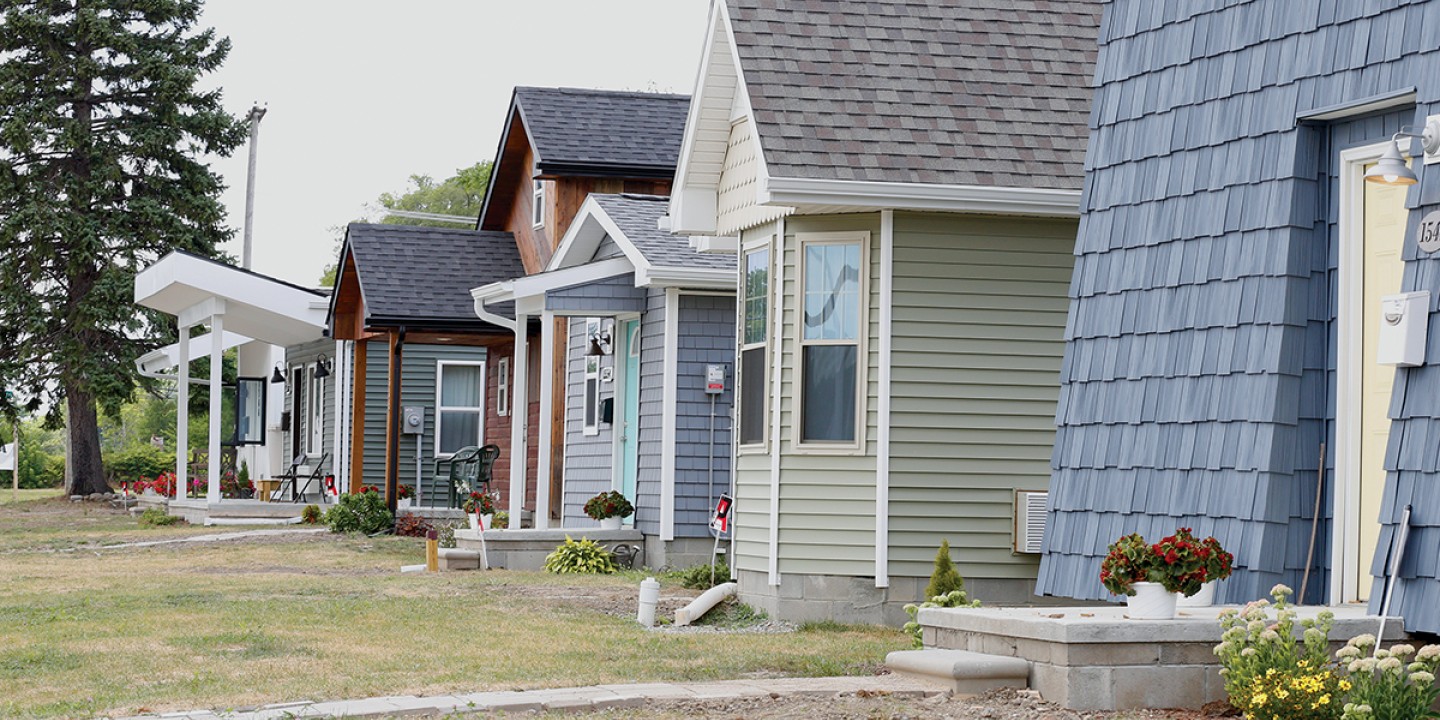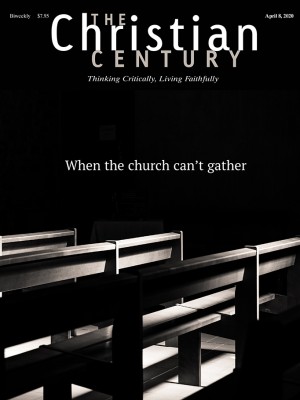Amid Detroit’s housing crisis, tiny homes offer residents new hope
A project that helps build pride, confidence, and community

One day Stephanie Donaldson saw a man weeping in his car. The Cass Community Social Services security officer approached him to ask what was wrong. He recalled growing up on that Detroit block and learning to ride his bike there, but his childhood home had been torn down years ago. Now Cass was building houses there—the first new construction in 50 or 60 years—and it moved him to tears.
The building project is no ordinary one. It takes an innovative model for affordable housing and adapts it for a city that is rebounding, but where development often neglects the needs of low-income residents. Cass launched its tiny homes project just three years after Detroit declared bankruptcy in 2013.
Read our latest issue or browse back issues.
Each house is a single-family home of 250–400 square feet, on its own lot with a lawn. The first phase of 25 homes is wrapping up; workers will break ground for the final five homes this spring. Project leaders are deciding how many homes will be in the second phase—they will be slightly larger, for families—and estimate that construction will begin later this year.
The 20 completed homes are occupied by single people and couples who were already in Michigan and living on little income: senior citizens, college students and other young people who have aged out of foster care, and people who were previously homeless or incarcerated. At the core of the tiny homes project are economic mobility and a reminder, to both the residents and their neighbors, that they have dignity. This is also Cass’s message to visitors from around the world—Donaldson estimated that as many as 100 people drive through to see the tiny homes on any given day.
Donaldson used to work for the Michigan State housing authority; she “hated it because [the buildings] all looked alike.” She relishes the fact that the tiny homes all look different. Donaldson spoke of a resident who is 65, who had never owned a home before: “Now it’s her tiny mansion.”
Faith Fowler, senior pastor of Cass Community United Methodist Church and executive director of the independent social service organization, writes in Tiny Homes in a Big City and This Far by Faith that she wanted to build single-family homes because Detroit has a history of them in the past century, more so than some other cities. Before embarking upon the project, she investigated various models for affordable housing, including those focused on efficiency and the maximum possible number of units. Each model has its trade-offs, and Fowler is aware of them. Her book on the tiny homes, available through the organization’s publishing house, responds to all the questions she and Cass have been asked about why they chose this approach. Fowler stresses asset building as crucial for people to escape poverty: assets allow people to borrow money without seeking payday loans and to pass on wealth to family members.

Listening to people who receive services from Cass was a large part of conceiving the project. “They’ll tell you what they need and the obstacles they’re facing,” Fowler said, seated in a meeting room at Cass.
The tiny homes don’t segregate low-income residents in an area separate from others. They are built to blend into the wider neighborhood. And because they are located near the the organization’s other services, tiny homes residents will have access to programs such as community gardens, a medical clinic, and GED classes. While Cass Community Church is four miles away, the social services organization has its own midweek service, and there are other churches and a mosque nearby.
The plan is for a few lower-income Cass staff members to live in tiny homes as well. While entry-level positions pay a living wage with benefits for people who are single, Fowler acknowledges that staff who support family members have to stretch their income further. And not all staff work full time; for example, some are on disability.
The project also includes a memorial garden and a park with space for social events open to all neighbors. Both opened in 2019. The neighborhood surrounding the Cass campus has been enthusiastic in its support of the tiny homes, Fowler said. She finds it affirming to have gotten support for this model from people who are often living in poverty themselves. “It’s not the way the rest of the country is thinking about affordable housing,” she said. “But to have the poor community say, ‘Yes, this is the answer’—it doesn’t get much better than that.”
New construction is something new for neighbors, noted Fowler, who was born and raised in Detroit. Though located less than a mile from the stately houses of the Boston-Edison Historic District, where some houses are on the market for more than half a million dollars, the area where the tiny homes are being built had become depopulated. Residences that went up beginning in 1915 were torn down for a freeway in the 1950s. They continued being demolished until, by 2010, nearly all were gone.
“To have new houses going in is really exciting to this community,” Fowler said.
Prior to this project, Cass Community Social Services was already offering a roof over people’s heads. It runs overnight, emergency, and rotating shelters, and it has apartments in several buildings within walking distance of the tiny homes neighborhood, where residents include people with disabilities or severe mental illness. One of the buildings with permanent supportive housing is on the corner of the block across from where the tiny homes are welcoming new residents.
Each tiny home includes a full bathroom and a washer-dryer. Some are single level, while others include a loft reached by climbing a ladder—a floor plan that works well for younger residents without mobility challenges. One of the houses with a loft is occupied by a 23-year-old who aged out of foster care.
The program features what Cass calls a “rent-then-own” model; unlike many rent-to-own schemes, it’s designed to empower residents, not exploit them. Residents pay $1 per square foot each month for seven years for rent and upkeep. They are required to have an established source of income, to receive financial coaching, and to attend monthly classes on homeownership that also serve a community-building role. Residents pay their own electricity costs, which are estimated to be low given the energy efficiency of the tiny homes. At the end of seven years of meeting the requirements, residents will own the home. They’ll assume responsibility for it and all related bills—but not a mortgage.
Owning rather than renting fosters pride and responsibility for the place where you live, Fowler argues, as well as a sense of safety: landlords can put tenants out on the street with little notice.
“To say ‘this is mine’ is huge,” Fowler said. “Some of them have never even owned furniture before.”
The program sees this pride as being amplified by the fact that each home is unique. Low-income people are used to receiving things that are uniform, and Cass could have simply offered three or four standard floor plans. Instead, the tiny homes have striking designs, some of them donated by architects. One is in a Tudor style, another Victorian; others have a more modern look.

Cass staff researched existing tiny home plans to learn from what had been done and improved upon elsewhere. There are cathedral ceilings and specially designed windows that make the interiors feel bigger. While there is limited storage space, what space does exist is creatively incorporated into the design and the furniture. In the 250-square-foot Cape Cod, there are shelves in corners and drawers under the couch.
One house includes design elements such as reclaimed barn wood from northern Michigan. Most lack a back door, which isn’t required for a home under 500 feet. At 400 square feet, they’re the size of many city apartments—though they don’t feel boxy or sterile.
Because each house has its own design, and because some of them look like a shrunken version of a larger home, the tiny homes appear almost imaginary. Even on a gray day, there was a magical feel to the block where the houses had been completed—at least until the end of block, where you can see the fence across the street that prevents anyone from tumbling down the hill to the expressway below.
Fowler wanted to build the tiny homes without government funding, “primarily because government dollars can be slashed or eliminated at any time.” She found fundraising has been easier than expected; the tiny homes have received wide faith-based support from across the state. In the past three years, while political passions have sometimes made it hard for families and congregations to talk to each other, “this project has brought people out of the woodwork,” Fowler said. “It has given us a common language.” She likens it to an urban barn raising. “It has been thrilling to see how people have been galvanized.”
There are many aspects of the tiny homes that can appeal to groups in different places on the political and social spectrum. Conservative congregations—and local corporations such as Ford and General Motors—can be drawn by connections between homeownership and personal responsibility. More progressive churches likely appreciate naming and addressing inequality, as well as the homes’ energy-efficient designs and appliances and their solar panels.
For everyone, there’s the appeal of a discrete, concrete project. It’s divisible into chunks that a single company or congregation can take on, or even a subset of one—one youth group raised all of the funds for one tiny home. Such a project capitalizes on a classic element of many mission trips (the one that can go awry with the proverbial wall that gets painted over and over by different church youth groups): the sense of having built something, complete with photo ops.
St. Kenneth Catholic Community in Plymouth, Michigan, sponsored one of the tiny homes, which is now complete and occupied as of July. Gayle and Jim Snider, coordinators of Christian service for St. Kenneth, volunteer at a local homeless shelter. The security guard there, who receives services from Cass, mentioned the project to the Sniders.
They invited Fowler to speak to their Christian service group, which came to see the project as something more than slapping bandages on the wounds of homelessness. The entire congregation made an initial deposit, after which 60 members contributed to the registry to furnish the house and 17 took part in finishing the construction.
“Detroit is in a phase of revitalization or renaissance,” Gayle Snider said, and this is a chance to work on solutions to problems one neighborhood at a time.
In addition to raising a total of $42,000, including the furnishings, a group of church volunteers ranging from teenagers to a 75-year-old hung and painted cabinets, tiled the bathroom and kitchen, landscaped the yard, and laid the sidewalk during Labor Day weekend 2018. One of them was a carpenter.
The parish of 2,700 families, which is 23 miles from the tiny homes, continues to have a relationship with Cass. The congregation has made contacts with local people in the building trades. For example, a plumber gave them some plumbing fixtures, and they’ve taken two complete kitchen sets down to the tiny homes.
“People call us and say, ‘We have some countertops, could Cass use them?’” Jim Snider said. “That was another huge source of pride and joy.”
He noted that even if a congregation can’t raise all of the funds for a home, several can collaborate to do so and help a person leave life on the streets. The project started with “a neighborhood that was a vacant field,” he said. After the arrival of “families there that have pride in their home, now we have a neighborhood that’s starting to turn around.”
The tiny homes project hasn’t asked for exceptions from any ordinances, and the city government has not made anything hard for them, Fowler said. Compared to a lot of the development projects that draw the attention of city officials, “we’re very small fish.”
At the location of the old Tiger Stadium, for example, there will be a $30 million mixed-use development with more than 100 residences. Lola Rushin, who joined the Cass staff after growing up in Detroit, wonders who can afford some of the new houses and businesses in the city. At the same time, she said, “if we want the city to be robust again, we have to be open to it. It’s good that it’s coming back to life.”
Visiting Detroit, I couldn’t help but compare what I saw to the new construction of the past two decades in the area where I grew up in inner-city Washington, D.C. Within walking distance of the four-flat that was my childhood home there is now a shopping mall, surrounded by luxury apartment buildings and businesses catering to younger professionals like me. A photo on a historical sign reaches back farther than I can in my mind’s eye, showing the row of dime stores that were there in the 1940s. One of them was still around for my family and other bargain hunters during my childhood; it stood among liquor stores and vacant lots.
Questions popped up like the multistory buildings: Who benefits from the new construction? Do the residents of the nearby affordable housing view the hip bars and restaurants as bringing jobs and money to the neighborhood or only as adding to class divides? Is any economic development good on balance when compared with empty stretches of gravel and weeds?
In her 2011 book The Next American Revolution, Grace Lee Boggs—a longtime Detroit activist and writer—contrasts the grassroots revitalization efforts in which she participated with “multibillion dollars’ worth of megaprojects advanced by politicians and developers that involve casinos, giant stadiums, gentrification.” Boggs, who died a centenarian in 2015, had arrived in the 1950s to a Detroit that was “the national and international symbol of the miracle of industrialization” and saw it become “the national and international symbol of devastation and deindustrialization.” Those forces, along with depopulation, “turned the city into a wasteland.”
On a tract of wasted land, the tiny homes project staff and residents are building a community. When compared to the challenge of equitable development in Detroit or the need for affordable housing nationally, their impact is as small as the houses. Yet perhaps they are a sign and a concrete example of Boggs’s hope come to life: that “in its dying, Detroit could also be the birthplace of a new kind of city.”
A version of this article appears in the print edition under the title “Tiny homes, big impact.”






